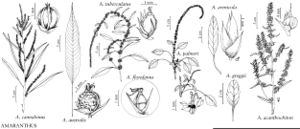Difference between revisions of "Amaranthus greggii"
Proc. Amer. Acad. Arts 12: 274. 1877.
FNA>Volume Importer |
FNA>Volume Importer |
||
| Line 48: | Line 48: | ||
|publication year=1877 | |publication year=1877 | ||
|special status= | |special status= | ||
| − | |source xml=https://jpend@bitbucket.org/aafc-mbb/fna-data-curation.git/src/ | + | |source xml=https://jpend@bitbucket.org/aafc-mbb/fna-data-curation.git/src/f6b125a955440c0872999024f038d74684f65921/coarse_grained_fna_xml/V4/V4_819.xml |
|genus=Amaranthus | |genus=Amaranthus | ||
|subgenus=Amaranthus subg. Acnida | |subgenus=Amaranthus subg. Acnida | ||
Revision as of 20:02, 24 September 2019
Plants glabrous or glabrescent. Stems erect to ascending, much-branched from base, 0.3–1 m. Leaves: petiole shorter than blade; blade ovate, or rhombic-ovate to elliptic, 1.5–4 × 0.5–2 cm, thick, coarse, base cuneate to rounded, margins entire, plane or irregularly undulate, apex rounded-obtuse to emarginate, with terminal mucro. Inflorescences mostly terminal, spikes to panicles, usually erect, thick, flexible. Bracts: of pistillate flowers with short, excurrent midrib, 1.5–2.5 mm, shorter than tepals, apex acute or acuminate; of staminate flowers shorter than tepals, apex acute. Pistillate flowers: tepals with dark, prominent midrib not excurrent, spatulate, subequal, 2–3 mm, apex obtuse to subacute, with terminal mucro; style branches spreading; stigmas 3. Staminate flowers: tepals 5, equal, 2–3 mm, apex obtuse to subacute; inner tepals: with apex indistinctly mucronulate; stamens 5. Utricles light brown, elliptic, 3 mm, equaling tepals, walls somewhat fleshy, smooth, indehiscent. Seeds dark brown, 1.2–1.7 mm diam., shiny.
Phenology: Flowering summer–fall.
Habitat: Coastal sand dunes, sea beaches
Elevation: 0-50 m
Distribution
La., Tex., Mexico.
Discussion
According to J. D. Sauer (1972b), Amaranthus myrianthus Standley most probably is a hybrid between A. arenicola and A. greggii.
Selected References
None.
